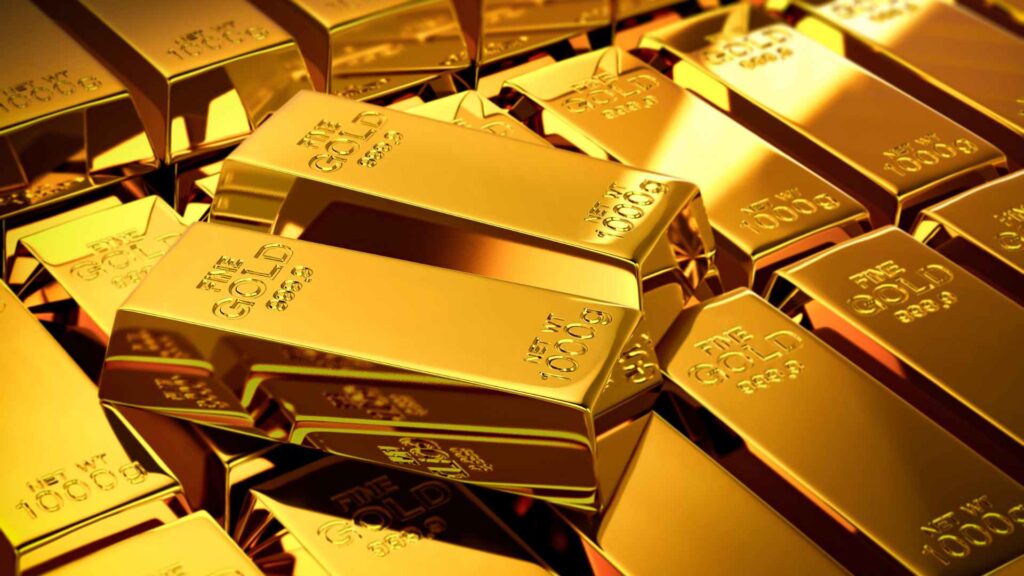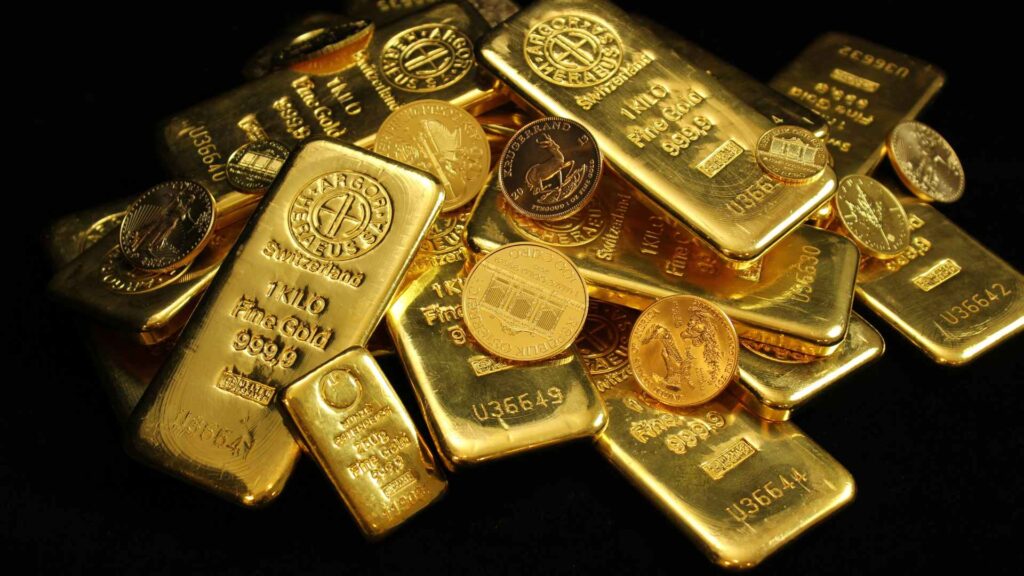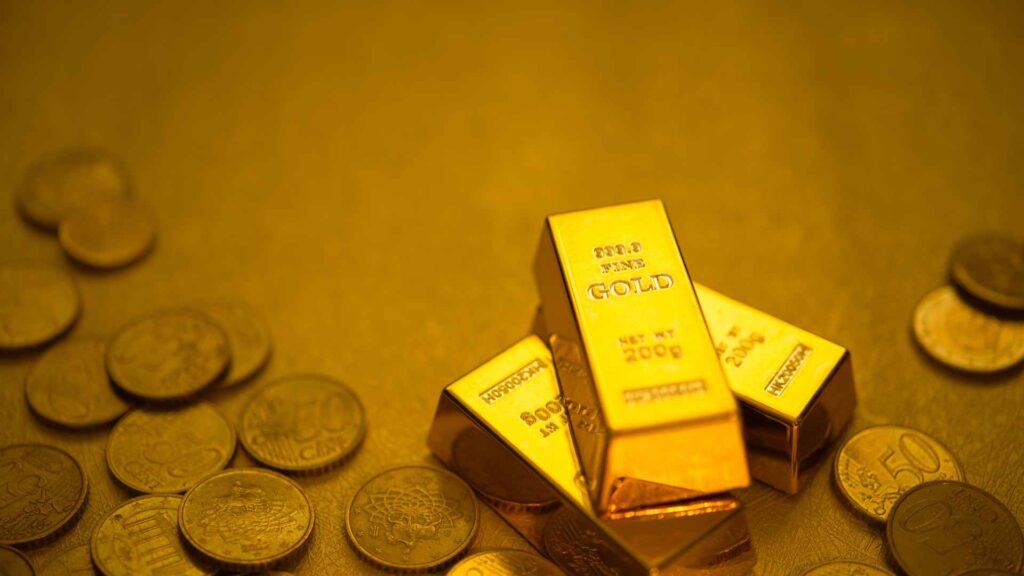Gold has captivated humanity for millennia with its beauty, rarity, and incredible properties.
This ultimate guide dives deep into gold’s historical, scientific, cultural, and economic significance.
You’ll learn over 145 fascinating facts that reveal why gold is so precious. Let’s uncover the glittering truths about this timeless treasure!
The History of Gold
- Gold has been used for over 6,000 years, dating back to ancient Mesopotamia.
- The oldest gold artifact is a 6,000-year-old necklace from Bulgaria’s Varna Necropolis.
- King Tutankhamun’s burial mask contains about 22 pounds of gold.
- The first gold coins were minted in 550 BC by King Croesus of Lydia.
- Gold fueled the California Gold Rush in 1848, drawing 300,000 people westward.
- The Incas referred to gold as “the tears of the sun.”
- Ancient Egyptians used gold leaf to decorate tombs and temples.
- Gold was often used as currency in ancient China as early as 1091 BC.
- Roman Emperor Nero debased the gold currency to fund his lavish lifestyle.
- Gold played a critical role in medieval alchemy, with alchemists attempting to create it from base metals.
- The phrase “gold standard” originates from the monetary system that used gold to back currency.
- Gold mining in Africa dates back to 2000 BC.
- Spain extracted 35,000 pounds of gold annually from the New World during the 1500s.
- Gold was the reason for numerous expeditions during the Age of Exploration.
- The famous El Dorado legend centers around a golden city that explorers sought in South America.

Gold in Science and Nature
- Gold is a chemical element with the symbol “Au” from the Latin “aurum.”
- It is the most malleable metal on Earth, capable of being beaten into sheets thinner than paper.
- Gold conducts electricity better than most metals, making it vital in electronics.
- Gold is chemically inert, meaning it doesn’t tarnish or corrode.
- Meteorites often contain gold, contributing to Earth’s gold supply.
- The human body contains trace amounts of gold, primarily in the blood.
- Gold nanoparticles are used in cancer treatments and medical diagnostics.
- Pure gold reflects infrared radiation, making it essential in astronaut visors.
- Gold is found in seawater, though extracting it is not cost-effective.
- It is believed that all the gold on Earth originated from supernova explosions.
- Gold is an excellent conductor of heat, used in industrial and scientific applications.
- Earth’s core is thought to contain vast amounts of gold, inaccessible to mining.
- White dwarf stars sometimes contain crystallized gold.
- The total amount of gold ever mined could fit into a cube measuring about 21 meters on each side.
- Gold is used in nanotechnology to create efficient solar panels.
Gold and Human Culture
- Gold has been associated with the divine in many religions, symbolizing purity and immortality.
- Olympic gold medals are made primarily of silver, with a thin gold coating.
- Wedding bands are traditionally gold due to its symbolism of eternal love.
- Gold is often used in awards and trophies to signify achievement and success.
- The golden ratio (1.618) is a mathematical concept tied to beauty and design.
- Gold leaf is used in art, including religious icons and paintings.
- Many ancient cultures believed gold possessed healing properties.
- In Hinduism, gold is considered sacred and is part of religious ceremonies.
- Gold jewelry is a traditional gift in many cultures for newborns and weddings.
- The “golden age” metaphorically represents times of prosperity and happiness.
- Alchemists associated gold with the sun and transformation.
- The ancient Greeks believed gold was a dense combination of water and sunlight.
- Gold adornments have been used to showcase social status across civilizations.
- Golden crowns were symbols of power in ancient kingdoms.
- Gold is a popular subject in mythology, often depicted as the ultimate treasure.

Gold in Modern Uses
- Gold is a critical component in smartphones and computers.
- Dental crowns and fillings often use gold due to its durability.
- High-end audio cables sometimes use gold for better conductivity.
- Gold is used in space technology for satellite components.
- Many luxury cars feature gold accents in interiors.
- Gold is an ingredient in some beauty products, like face masks.
- Investors use gold bars and coins as a hedge against inflation.
- Gold-plated connectors are common in electronics for corrosion resistance.
- The jewelry industry accounts for over 50% of global gold demand.
- Gold is used in glassmaking to create red and purple hues.
- Scientists use gold in environmental studies to detect pollutants.
- Gold is sometimes used in gourmet dishes as edible gold leaf.
- Gold wires are essential in microchip manufacturing.
- High-quality musical instruments use gold for its acoustical properties.
- Gold coins remain popular collectibles and gifts worldwide.
Unique Properties of Gold
- Gold is so soft it can be scratched with a fingernail in pure form.
- It has a melting point of 1,064°C (1,948°F).
- Gold is non-toxic and safe for ingestion in small quantities.
- A single ounce of gold can be drawn into a wire 50 miles long.
- Gold reflects 98% of infrared radiation.
- It has been found on every continent on Earth.
- The karat system measures the purity of gold, with 24 karats being pure gold.
- Gold alloys are created to increase durability for practical uses.
- Gold’s density is 19.32 grams per cubic centimeter.
- The atomic number of gold is 79.
- Gold is one of the least reactive metals, making it ideal for long-term use.
- Gold’s yellow hue is due to its absorption of blue light.
- The largest gold nugget ever found weighed 173 pounds.
- Gold is rarer than diamonds in Earth’s crust.
- It does not oxidize, making it ideal for timepieces and electronics.

Fascinating Facts About Gold
- Gold coins are sometimes found in sunken shipwrecks, preserved for centuries.
- In ancient times, people drank liquid gold as a cure for ailments.
- The U.S. Treasury’s gold reserves are stored at Fort Knox.
- The Golden Gate Bridge isn’t made of gold but gets its name from the Golden Gate Strait.
- Gold can be made artificially in laboratories but at a high cost.
- The purity of gold is tested using acid solutions.
- Gold has been found on the Moon and Mars.
- In Japan, gold is used in traditional kintsugi pottery repair.
- A gold bar the size of a matchbox can be flattened to cover a tennis court.
- Gold tattoos are a modern trend for luxury body art.
- The largest gold mine in the world is the Grasberg mine in Indonesia.
- Gold foil is used in modern architecture to create reflective surfaces.
- Ancient Greek athletes received olive wreaths and gold as prizes.
- Gold flakes are often used in luxury spirits and chocolates.
- Goldfish are named for their color, resembling the metal.
- The Taj Mahal incorporates gold accents in its design.
- Pirates famously sought gold coins and treasures.
- Many royal crowns feature gold as their base metal.
- A single cubic foot of gold weighs around 1,200 pounds.
- Gold’s value has remained relatively stable over centuries.
- Some traditional medicines use powdered gold.
- The concept of “gold diggers” originates from the Gold Rush era.
- Ancient Romans imported gold from Africa and India.
- Gold is recyclable and can be repurposed endlessly.
- The term “gold fever” describes the excitement of gold discovery.
- Gold’s rarity contributes to its high value.
- Gold mines can extend miles underground.
- Gold doesn’t tarnish when exposed to air or water.
- In medieval Europe, gold was a symbol of divine right.
- The phrase “worth its weight in gold” highlights gold’s significance.
- Gold is sometimes used in luxury car paints to create a shimmering finish.
- The Pharaohs of Egypt considered gold to be the “flesh of the gods.”
- Gold thread is used in traditional textiles for ceremonial garments.
- The iconic Oscars statuette is gold-plated.
- Gold has been found in Antarctica, though mining is banned there.
- The Vatican uses gold in religious relics and artwork.
- Gold is used in underwater cables for its conductivity.
- During the Great Depression, Americans were required to exchange gold for currency.
- Some deserts contain trace amounts of gold particles in the sand.
- The legendary “Golden Fleece” may symbolize gold panning techniques used in ancient Georgia.
- Gold-coated lenses protect surgeons’ eyes during laser procedures.
- The Guinness World Record for the largest gold bar is a single bar weighing over 250 kg.
- Gold nanoparticles are used in precision drug delivery systems.
- The 1933 Double Eagle gold coin is one of the rarest and most valuable coins in the world.
- Gold mines exist underwater, primarily off the coasts of Papua New Guinea.
- Gold’s scarcity in space exploration materials makes it vital for advanced equipment.
- India is the largest consumer of gold jewelry globally.
- Gold prices often rise during global economic instability.
- The phrase “golden handshake” refers to a lucrative severance package.
- In Norse mythology, gold is often associated with divine beings and wealth.
Gold’s allure spans history, science, and culture, making it one of the most treasured elements on Earth.
Whether in ancient artifacts or modern technology, gold continues to dazzle and inspire
